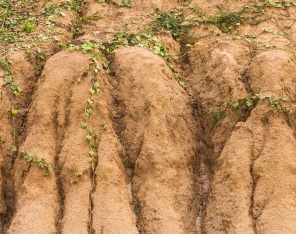
Direct Seeding Vs Hydroseeding

Two of the most common methods of large scale revegetation are direct seeding and hydroseeding. While both methods can have a similar result, each has its own advantages and disadvantages, along with requirements that should be considered before deciding which method to choose.
Direct seeding
Direct seeding methods involve the sowing of seeds directly into the soil to achieve germination and establishment. There are two commonly used direct seeding methods known as broadcast or drill seeding. The broadcast method is simply seed being mechanically spread over the surface of the soil from the back of a tractor or truck. It generally requires soil that is already healthy and contains adequate nutrients, with a good coverage of top soil. It requires some ongoing maintenance to achieve growth, such as irrigation or adequate rainfall. However, seeds can still be susceptible to wash away in moderate to heavy rain events or even when high winds are present, leaving little or no seed behind. Despite being one of the least costly methods available, broadcast seeding is often not the best choice to ensure that you get the results you’re looking for.
Drill seeding has similar requirements to the broadcast method but tends to have better results. The seed is drilled into the soil at a specific depth and spacing. This means the seed is kept moist and protected from washing away before it germinates. It also allows for more consistency and better control over the amount of seed used. Drill seeding will usually require a reasonably soft topsoil so that the seed can easily be worked into the ground. Although it is a cheaper option than hydroseeding, drill seeding requires the surface be level as the machinery must be able to navigate over it with ease.
Hydroseeding
Hydroseeding is the technique of mixing water and seed inside a hydroseeder truck with fertiliser, and often a biodegradable glue-like binder, before being sprayed onto the soils surface. The binder helps the seed to stay in place long enough to germinate without being washed away by water runoff or high winds. This mixture can be sprayed large distances hydraulically through high-pressured cannons and hoses, enabling it to be applied on uneven surfaces, moderate slopes and in hard to reach areas. The mixture also contains a dye, which is useful as a marker to see where seed has been sprayed, while helping to ensure even and thorough coverage.
Hydroseeding provides the benefit of allowing all types of seed shapes and sizes to be used for revegetation and does not require pelletised seeds, unlike direct seeding. Hydroseeding generally doesn’t require soil to be in perfect health as direct seeding methods. If there are inconsistencies found in the soil, soil amendments are easy to include in the hydroseeding mixture. Hydroseeding is slightly more costly than direct seeding methods but has the added benefits of being able to alter the mixture with product to secure the seed in place, a faster and more efficient application method, increased overall vegetation coverage and reduced on site time, cutting labour costs.





